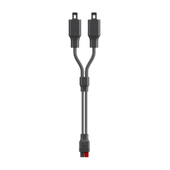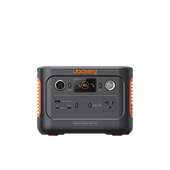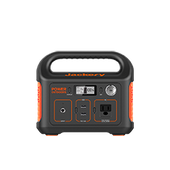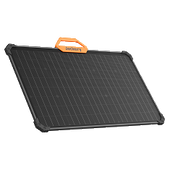Power Rating Ultimate Guide: What Is, Formula, Examples
The power rating of an electrical appliance is the energy required by the device to run properly. It shows the operating conditions for the optimum performance. It helps the consumers to choose the required device and arrange energy resources for it. The heating appliances like ovens, kettles, irons, and microwaves have high power ratings and thus contribute more to the electricity cost. Similarly, air conditioners are also high-power eaters.
Also, when you are planning an off-grid setup, you need to know the power ratings of the appliances you will be using. It will help you to decide the size of the solar generator you are going to use. Suppose you are planning on using high-power rating appliances. In that case, you should use large-capacity Jackery solar generators like Jackery Solar Generator 3000 Pro, 2000 Plus, and 2000 Pro with higher rated and peak power.
|
Products |
Image |
Capacity |
Rated Power |
Peak Power |
Battery |
 |
3024Wh |
3000W |
6000W |
Lithium-ion Battery |
|
 |
2042.8Wh |
3000W |
6000W |
LFP (LiFePO4 battery) |
|
 |
2,160Wh |
2200W |
4400W |
Lithium-ion Battery |
What Is Power Rating?
Power rating describes the total electrical power required for optimum operation of an electric appliance. This quantity is stated on the product label and also in the product literature. So, if the label says the rated power is 1850-2000W, it means the appliance needs this much power every second. If an electric kettle has a power rating label of 3 KW, then you need enough power for the kettle throughout the operation.
Power Rating Formulas & Examples
You can find the power rating of all electronic and electrical devices on the product label and also in the product information literature. It also shows the maximum power rating that the appliance can safely work with. Sometimes, the information about the electric cable and plug is also included. All this information is important to know for the safe working of the appliance and also helps when you change the power source or move to a place with different specifications of wall outlets.
Now, we will calculate the power rating formulas to assist you in accurately calculating your appliance-rated power.
Power = Voltage x Current
In symbols, we can say;
P=VI
We represent P in watts, V voltage in volts, and I current in amperes. So, if a circuit has a voltage of 1 V and a current of 1 Amp is flowing through it, its power is 1 Watt.
Another way to calculate power rating is based on the energy transferred by an electric circuit in a given amount of time.
Power = Energy Transferred in Joules / Time
Symbolically;
P = W(or E) / T
It is also helpful to calculate the efficiency of a device to choose the best device which is the most efficient.
Efficiency = useful output / total input energy
So, if we supply 100 watts of power to a circuit and it converts all of it into useful output, then it is 100% efficient. On the other hand, if a bulb takes 100 watts of energy and converts 90% of it into heat energy with only 10% of light output, then it is only 10% efficient because heat is not the required output.
Common Appliances Power Rating
Efficient electric appliances help you save energy and cost because they use less power to achieve the required performance level. Consequently, it is also good for the environment to use energy-efficient appliances.
The energy efficiency labels go from A+++ to D, where A+++ is the most efficient, and the D is the poorest). However, it is important to note that you can compare the efficiency of only the same type of appliances to each other.
Following is a list of the most common electric appliances used around us with their power ratings.
|
Appliances |
Power Rating (Watts) |
|
Central AC |
2000-5000 W |
|
Room AC |
1000 W |
|
Box Fan |
200 W |
|
Ceiling Fan |
120 W |
|
Table Fan |
10-25 W |
|
Laptop computer |
20 to 75 W |
|
Desktop PC |
80 to 200 W |
|
Printer |
100 W |
|
LCD monitor |
100 W |
|
Heater (engine block) |
150 - 1000 W |
|
Heater (portable) |
1200 W |
|
Heater (stock tank) |
100 W |
|
Heater (waterbed) |
400 W |
|
Upright Freezer |
1240 W |
|
Chest Freezer |
1080 W |
|
Refrigerator |
1200-1400 W |
|
Laptop |
20 - 75 W |
|
Desktop PC |
80 - 200 W |
|
Printer |
100 W |
|
LCD monitor |
100 W |
|
Coffee machine |
1000 W |
|
Dishwasher |
1200 - 1500 W |
|
Electric kettle |
1200 W |
|
Microwave |
600 - 1500 W |
|
Electric oven |
1200 W |
|
Hot plate |
1200 W |
|
Toaster |
800 - 1500 W |
|
LED bulb |
10 - 23 W |
What Does Rated Power Mean in A Generator?
The maximum power output and rated power of a generator are two different numbers, and it is important to understand both of them to efficiently use your generator. However, rated power is a more reliable measure of how much power your generator can produce.
Rated power defines how much electricity a generator can produce for a long time. On the other hand, maximum power output is the highest power a generator can produce. However, a generator should not be operated at its maximum power for more than half an hour. The rated power is typically 90% of the maximum power.
Similarly, there is the rated power of solar panels as well, which shows how much power a solar panel produces in optimal conditions. The rated power of solar panels is achieved when optimal direct sunlight is available at the perfect temperature and the solar panels are positioned at the proper angle.
The rated power of all your required appliances and the rated power of your solar panels these two pieces of information help you estimate how many solar panels you will need to fulfill your requirements.
Generator Power Explained
In the previous sections, we have discussed power rating in detail. Now, let us dive into more terms related to generator power. While choosing the best generator for yourself, some additional information will come in very handy.
We will discuss the standby power rating, prime power rating, and continuous power rating in this section to provide more clarity.
Standby Power Rating
Standby power rating is relevant when the generator is used as a backup power source. It means you will use this when your power supply fails for any reason, and you use your generator as a backup. It is recommended that the average load factor of the standby generator remains within 70%-85% of the specified standard power rating. This standard power rating should be used for short spans only. Some manufacturers even mention that standby generators can be used for a specific number of hours yearly. Usually, the recommended maximum hours are 200-500 hours a year.
Prime Power Rating
Prime power rating is relevant for the generators that are used as the main power source. This typically happens in off-grid setups. These generators can operate for long hours with variable loads. However, its prime power rating might be lower than the standby generators.
Continuous Power Rating
The continuous power generators are typically used in parallel with utility and co-generation applications. They can work for unlimited hours and can take constant load at 100 percent of the continuous rating.
Jackery Solar Generators with Higher Rated & Peak Power
The Jackery solar generators harness the power of sunlight and convert it into electric power. The Jackery solar generators stand out from other generators because of their compact design, advanced BMS system, fast solar and AC charging, and long lifespan. A solar generator combines solar panels, a power station, and a battery storage system. They collect solar energy through solar panels and then store it in their built-in solar battery. This energy needs to be converted into AC power to be used by appliances. This conversion takes place using an inverter.
Since no fossil fuel is used and there is no fuel cost as well, it is the best solution for off-grid systems, outdoor adventures, camping, van life, and also as an indoor emergency backup.

Jackery Solar Generator 3000 Pro
The Jackery solar generator 3000 Pro is a large capacity generator with a whooping 3024Wh/. It is a great option for an off-grid setup as it can power even larger appliances and over 99% of outdoor appliances. Despite its large capacity, you can charge within 3-4 hours, and it takes only 2.4 hours for wall outlet charging.
Its smart app control makes accessibility rather simple, and it can also work in very low temperatures, up to -20°C /-4°F.
Valued Customer Review
“We have an off-grid setup at our farms for which we have purchased the Jackery 3000 Pro. It is the company's latest product and we can vouch for its high performance and noise free operation. It powers up our electric oven, drill machine, lights and refrigerator. We are delighted with our purchase because even our pets are not a bit disturbed when it is running. ”

Jackery Solar Generator 2000 Plus
The Jackery solar generator 2000 Plus is a revolutionary new technology with an expandable capacity of 2-24 kWh. It can support large appliances up to 6000W, yet it can be charged within 2 hours using solar charging through the advanced IBC technology. Its long-lasting reliability with 10 10-year lifespan of LiFePO4 battery makes it a perfect choice for long-term use.
Valued Customer Review
“Portable, lightweight, high performance and fluctuation free. Highly recommended solar generator. Love your environment and invest in green and clean power solutions.”

Jackery Solar Generator 2000 Pro
The Jackery solar generator 2000 is characterized by its ultra solar charging that takes only 2 Hours for full charging. It has a 2160Wh Capacity with a 2200W Inverter, making it an optimal choice for home power backup support.
Its BMS system makes sure that the generator is safe for both indoor and outdoor use with voltage control, temperature control, short circuit protection, and other advanced safety features.
Valued Customer Review
“We have been using Jackery 2000 Pro for the last one year. It has successfully worked in all weathers and has been perfect even outdoors. We use it as a backup in rough weather when main power is not as reliable. ”

The following table summarizes the features of all recommended Jackery solar generators with capacity, peak power, and output ports.
|
|
Capacity |
Battery |
Output Ports |
Home Appliances |
|
3024Wh (3000W Rated, 6000W Peak) |
Lithium-ion Battery |
AC Output(x1): 120V~ 60Hz 25A Max |
Refrigerator(520W)=5 H TV(60W)=35 H Light(5W)=220 H Heater(1800W)=2.2 H Microwave(960W)=2.2 H Electric Grill(850W)=3 H Coffee machine(1080W)=3 H Mobile phone(29W)=101 Charges |
|
|
AC Output(x3): 120V~ 60Hz 20A Max |
||||
|
USB-C Output(x2): 100W Max, 5V⎓3A, 9V⎓3A, 12V⎓3A, 15V⎓3A, 20V⎓5A |
||||
|
2042.8Wh (3000W Rated, 6000W Peak) |
LFP (LiFePO4 battery) |
AC Output(×4):120V~ 60Hz, 20A Max, AC Output(×1):120V~ 60Hz, 25A Max |
Portable Air Conditioner(1150W)=1.9 H Electric Pressure Cooker(1080W)=1.7 H Microwave(1050W)=1.5 H Kettle(850W)=1.9 H Coffee Maker(550W)=2.8 H Electric Oven(800W)=2.1 H |
|
|
USB-A Output(x2): Quick Charge 3.0, 18W Max |
||||
|
USB-C Output(x2): 100W Max, (5V, 9V, 12V, 15V, 20V up to 5A) |
||||
|
2,160Wh (2200W Rated, 4,400W Peak) |
Lithium-ion |
AC Output(x3): 120V, 60Hz, 2,200W (4,400W Peak) |
Microwave(700W)=1.6 H Kettle(850W)=2 H Electric Drill(900W)=1.7 H Electric Pressure Cooker(1080W)=1.8 H Coffee Maker(1120W)=1.8 H Portable Air Conditioner(1150W)=2 H Electric Oven(1600W)=1 H Induction Cooker(2300W)=2.2 H |
|
|
USB-A Output(x2): Quick Charge 3.0, 18W Max |
||||
|
USB-C Output(x2): 100W Max, (5V, 9V, 12V, 15V, 20V up to 5A) |
Power Rating FAQs
1. What size of solar generator do I need for my home?
A home solar generator should be big enough to power large appliances, including refrigerators, ACs, TV, electric oven, etc. The Jackery solar generator 3000 Pro and 2000 Plus are great for home backup. The following formula allows you to calculate your appliance's working hours precisely on the generator power.
How to calculate the working hours of a solar generator
Working time = Capacity Wh * 0.85 / operating wattage of your TV
For example, a refrigerator consumes 500W.
The Jackery solar generator 2000 Pro Working time will be 2160Wh * 0.85 / 500w = 3.6 hrs.
These estimates are based on 85% efficiency of the generators. There is always some power loss during transmission and operation. By multiplying by 0.85, we incorporate a 15% loss of efficiency to make the estimates more accurate and reliable.
2. How do you calculate the generator power rating?
Generator power rating is expressed in Watts (W) or KiloWatts (kW). The formula for power is given by;
Watts = Volts X Amps.
Most of the time, the power rating of the generator is specified in the specification plate and also in the product literature.
3. What is the rated Voltage for a generator?
The rated Voltage of a generator depends on the generator output specification. For example, the Jackery solar generators have 120V in the AC ports, while the DC ports and USB outputs have different specifications.
Final Thoughts
Power rating is an important concept to understand while using any electric appliances for safe usage. When you use generators, power ratings become essential to know so that you connect the appliances that are compatible with the generator. In the above sections, we have discussed the power ratings, how to calculate, and how to use this concept in a generator context. The Jackery solar generators are much simpler to use because they come with an in-built BMS for protection against voltage fluctuations, battery overcharge, and overheating. Hence, your appliances are well protected when used with the Jackery generators.
Disclaimer:
The runtime mentioned for appliances powered by Jackery is for reference only. Actual runtime may vary under different conditions. Please refer to real-world performance for accurate results.










































































































Leave a comment